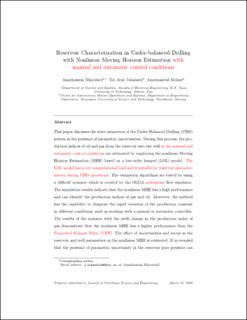| dc.contributor.author | Nikoofard, Amirhossein | |
| dc.contributor.author | Molaei, A | |
| dc.contributor.author | Johansen, Tor Arne | |
| dc.date.accessioned | 2021-02-09T12:41:34Z | |
| dc.date.available | 2021-02-09T12:41:34Z | |
| dc.date.created | 2020-12-21T11:30:42Z | |
| dc.date.issued | 2020 | |
| dc.identifier.issn | 0920-4105 | |
| dc.identifier.uri | https://hdl.handle.net/11250/2726910 | |
| dc.description.abstract | This paper discusses the state estimation of the Under-Balanced Drilling (UBD) system in the presence of parametric uncertainties. During this process, the production indices of oil and gas from the reservoir into the well in the manual and automatic control conditions are estimated by employing the nonlinear Moving Horizon Estimation (MHE) based on a low-order lumped (LOL) model. The LOL model has a low computational load and is suitable for reservoir characterization during UBD operations. The estimation algorithms are tested by using a difficult scenario which is created by the OLGA multiphase flow simulator. The simulation results indicate that the nonlinear MHE has a high performance and can identify the production indices of gas and oil. Moreover, the method has the capability to diagnose the rapid variation of the production constant in different conditions, such as working with a manual or automatic controller. The results of the scenario with the swift change in the production index of gas demonstrate that the nonlinear MHE has a higher performance than the Unscented Kalman Filter (UKF). The effect of uncertainties and errors in the reservoir and well parameters on the nonlinear MHE is evaluated. It is revealed that the presence of parametric uncertainty in the rdeservoir pore pressure can significantly affect the estimators' performance. | en_US |
| dc.language.iso | eng | en_US |
| dc.publisher | Elsevier | en_US |
| dc.rights | Attribution-NonCommercial-NoDerivatives 4.0 Internasjonal | * |
| dc.rights.uri | http://creativecommons.org/licenses/by-nc-nd/4.0/deed.no | * |
| dc.title | Reservoir Characterization in Under-balanced Drilling with Nonlinear Moving Horizon Estimation with Manual and Automatic Control Conditions | en_US |
| dc.type | Peer reviewed | en_US |
| dc.type | Journal article | en_US |
| dc.description.version | acceptedVersion | en_US |
| dc.source.journal | Journal of Petroleum Science and Engineering | en_US |
| dc.identifier.doi | 10.1016/j.petrol.2020.107248 | |
| dc.identifier.cristin | 1862255 | |
| dc.relation.project | Norges forskningsråd: 223254 | en_US |
| dc.description.localcode | "© 2020. This is the authors’ accepted and refereed manuscript to the article. Locked until 7.4.2022 due to copyright restrictions. This manuscript version is made available under the CC-BY-NC-ND 4.0 license http://creativecommons.org/licenses/by-nc-nd/4.0/ " | en_US |
| cristin.ispublished | true | |
| cristin.fulltext | postprint | |
| cristin.qualitycode | 2 | |

